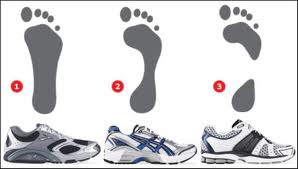Did you know that there are three main types of running shoes that are built to support your unique foot? Many of us go out to buy running shoes because they look good, we like the colors, the style, and if we are lucky – they are comfortable. However, there is a significant amount of science and technology that goes into developing running shoes that best suit the three most common types of foot arches: a flat arch (or pronated foot), a normal arch (or neutral foot), and a high arch (or supinated foot).1
Running shoes are structured mostly around mid-sole technology, which is located on the bottom of the shoe from mid-heel to the arch of the foot.2 This area is most important because that is where the shock absorption occurs, as the foot and makes contact with the ground.2 If you have poor shock absorption excess energy will continue to travel up the leg to the ankle, knee, hip, and low back – which, in some cases, can cause injury or discomfort while running.3 Pronation is the rolling inward of your foot, is your body’s way of absorbing and controling that shock. Problems can occur when you either overpronate (flat feet) or underpronate (supinate/high arches), because it can affect the shock absorption process.3
The three main types of running shoes are motion control, stability, and cushion.
1. Motion control shoes are designed for people with a flat arch or pronated feet. This type of shoe is typically more rigid and has a wider sole to control the excessive motion occurring at the foot.4
2. Stability shoes are designed for people that have a normal arch or neutral foot. This type of shoe typically has some rigidity and some cushioning to help support the mechanics of this foot type, which has normal pronation and shock absorption during running.4
3. The last type is a cushion shoe, which is designed for people with a high arch or supinated foot. This type of shoe is typically more flexible and cushioned to promote more pronation and shock absorption.4
Using these three categories as a guideline when purchasing your next pair of running shoes may help with improving comfort, decreasing soreness after running, and preventing overuse injuries.
So how do you know which type of shoe to buy?
Determine your arch type. The quickest and easiest way to determine this in your home is called the wet feet test.5 Place a paper bag on the ground with a pan of water next to it. Step your feet into the water and then onto the paper bag, step off the bag and observe the footprint left behind.5
![]()
If you see the entire outline of your foot then you likely have a flat arch or pronated foot.
![]()
If you do not see the entire outline of your foot and there is a little space left where the arch is located, you likely have a normal arch or neutral foot.
![]()
If you have just a fine line connecting your heel area to the ball of your foot, then you likely have a high arch or supinated foot.5
Of course, this is a less than scientific approach to determining what type arch you have but it will give you a general idea.
If you would like a more precise evaluation of your arch and what type of shoe would be the best for you, stop in to the nearest Sports PT location and chat with a physical therapist. We can evaluate your feet in both a static position and dynamic position (such as running or walking) to help decide what would be the best type of shoe for you.
Overall, it is important to consider a multitude of factors when purchasing your next pair of running shoes. Arch type is just one of them. Your feet and body will thank you.
Happy and safe running!
References:
1 Loda, R. 3 Types of Running shoes for 3 types of feet. Running Shoes Guru. http://www.runningshoesguru.com/2009/03/3-types-of-running-shoes-for-3-types-of-feet/. Published 2009.
2 Loda, R. Anatomy of a Running Shoe. http://www.runningshoesguru.com/2009/03/anatomy-of-a-running-shoe/. Published 2009.
3 Loda, R. Running shoes 101: Pronation and shock absorption. http://www.runningshoesguru.com/2009/03/running-shoes-101-pronation-and-shock-absorption/. Published 2009.
4 RunningShoeTypes. Running Shoe Types. http://www.runningshoetypes.com/. Published 2009. Updated 2012.
5 Loda, R. A simple test to determine your foot type. http://www.runningshoesguru.com/2009/03/a-simple-test-to-determine-your-foot-type-neutral-pronator-supinator/. Published 2009.

